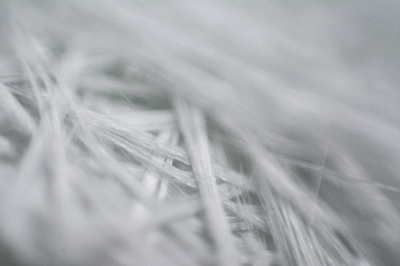What Is Fiberglass?

Fiberglass is a type of industrially produced inorganic fiber made by stretching molten glass into a fiber shape.
Fiberglass is made of glass and is used in composites with resin or cement to reduce weight and improve durability. Alkali-free glass is also often used for fiberglass.
Uses of Fiberglass
Applications of fiberglass are expanding every year, and demand is expected to continue to grow in the future. The main applications are as follows:
- Automotive parts and electronics products
- Reinforcing material for housing equipment
- Reinforcing material for concrete
- Reinforcing material for synthetic sleepers, etc.
Resins used in automotive parts are composited with fiberglass to increase strength and contribute to weight reduction of automobiles. Fiberglass is also used in electronic products to improve precision and in construction materials to provide high durability.
Principle of Fiberglass
Fiberglass production begins with melting glass at temperatures of 1,300°C or higher. The melted glass is passed through microscopic pores, the glass is drawn out on the order of microns, and the glass is processed into a thread shape by winding. Diameters can be produced in the range of 4 to 25 μm. The most suitable fiberglass should be selected for each application.
Types of Fiberglass
Fiberglass can be divided into two major types: E-fiber glass and AR-fiber glass.
1. E-Fiberglass
Alkali-free fiberglass is used to increase the strength of resin. It has excellent insulation properties. It is composited into resins to improve insulation and heat resistance.
2. AR Fiberglass
Fiberglass containing a high concentration of zirconia. It has excellent alkali resistance and acid resistance. AR Fiberglass with alkali resistance can be composited into cement.
Other Information on Fiberglass
1. Hazards of Fiberglass
There are almost no health hazards in handling fiberglass. Fiberglass is often confused with inorganic fibers such as asbestos because of its similarity, but they are different substances.
Asbestos is a crystalline fiber with a thickness of about 0.1 µm. Because it is so thin, it can easily reach deep into the lungs when inhaled. Once asbestos reaches the lungs, it is not discharged out of the body and accumulates, causing diseases such as pneumoconiosis.
Fiberglass is an amorphous fiber with a thickness of 4~25µm. Even if inhaled, most of them do not reach deep into the lungs because they are removed by the nose and bronchial tubes. Even if they do enter the body, the body’s immune system will expel them from the body in a short period.
The dust generated during the processing of fiberglass generally has a health hazard classification. As mentioned above, it is a different substance from asbestos, so inhaling it will not cause pneumoconiosis or other health problems. Even so, it is better to avoid inhaling dust as much as possible from a health perspective, so ventilation and the use of dust masks are recommended.
2. Difference Between Fiberglass and Carbon Fiber
Fiberglass and carbon fiber are both fiber-like substances, but they are different materials. Fiberglass is a fiber of glass. It is manufactured by melting glass in a high-temperature kiln and pulling it out through a nozzle at high speed. It has the properties of glass, such as heat resistance, nonflammability, and chemical resistance.
Carbon fiber, on the other hand, is a fiber-reinforced plastic that incorporates carbon fibers. It is produced by carbonizing petroleum or acrylic fibers. Despite its high strength, it is extremely lightweight.